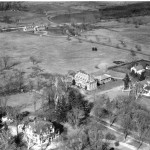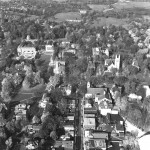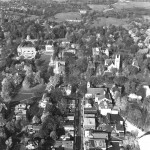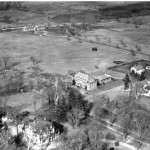FJ #10 Syndicate Road Woods
December 4th, 2009
 Today was quite warm for a typical December day in Williamstown.  There was a nice breeze and the air was approximately 50 degrees Fahrenheit.  I observed much more of the terrain of my site today than I had been able to in the past due to the thick cover of leafy trees and shrubs.  Now that the branches were bare, however, I could see the true topography of the Syndicate Road Woods.
¬†¬†¬†¬†¬†¬†¬†¬†¬†¬†¬† Walking north along the stream one first encounters a large area, about 20 square feet, of low land on the stream‚Äôs eastern bank.¬† The lowland area forms a sort of semicircle shape bordering the stream, and it looks like someone has just taken a shovel and scooped out this area.¬† At the eastern edge of the semicircle, there is a 45¬į slope up about 8 feet to higher ground.¬† On this slope as well, there is a small, stream-like indentation running from east to west.¬† This has obviously been carved by water and now acts as a funnel for water from the top of the slope running into the stream.
            Continuing a trek northward, the land east of the stream suddenly becomes a cliff, and one now comes across another large lowland area in a semicircular shape, but this time on the western bank of the stream.  What is the cause of these formations?  Is it natural or man-made? The stream in the Syndicate Road woods does have its twists and turns, and like we saw at the Hoosic River, the stream could have changed course and dug out the lowland areas.  However, this is problematic because the stream at the Syndicate Road woods does not even come close to matching the power and amount of water held by the Hoosic, which is a fifth order stream.  Therefore, we must wonder, did the stream used to be larger and have more power? We know that the stream has been controlled by human hands because of the cement culvert that carries water from under Syndicate Road.  It is possible that the stream did carve out these semicircular areas and then shrunk down to its straight path through the middle.  Also, the strength of the stream 80-100 years ago when they built Syndicate Road could have been much more than it is today.  This is just one of the many natural mysteries found in the Syndicate Road woods.
Continuing north, the eastern bank of the stream becomes even steeper, about a 70¬į, 10 foot slope.¬† A deep crevice also runs from east to west, down this slope to the stream.¬† Up on the ‚Äúcliff‚ÄĚ, I also come across another mystery.¬† There is a bit of a crevice running north-south which eventually connects to the deeper crevice.¬† At one point, however, this small crevice becomes a more crater-like formation, about 2 feet deep.¬† I wonder if this crater was formed by a pool of water, but it is more likely that the hole was formed after a tree fell over, tearing out its roots and the ground that came along with it.¬† Water then most likely collected in the crater, and the resulting crevice was formed as the water sought a gravity-driven path down to the stream.¬† It is fascinating to study natural power of water at the Syndicate Road woods.¬† It can create canyons and cliffs and bring life to a woods that would otherwise seem dead.¬†¬†¬†¬† ¬†¬†
Next, I took a soil sample near the southern edge of the site.  I first had to clear away a 2 inch layer of leaves before I started to dig.  What I found was a layer of dark soil, about 2 inches thick, in which remnants of decaying leaves and organic matter could still be seen.  Then, for as deep as the shovel would allow me to dig, the ground was composed completely of clay.  Because of the recent rains, the clay was moist and cool.  Clay is a heavy soil, which has relatively poor drainage and aeration capabilities.  Although they usually hold more water than desired for optimal plant growth, clay does retain nutrients well.  Although the soil was not loam, the farmers that used to farm near Syndicate Road obviously figured out how to maximize the potential of a clay soil base.





 I continued on, not wishing to engage in a standoff with the deer.  I also noticed a large puddle south of Baxter Road that was at least 8 feet in length and width and showed the effects of the recent rain.  Many song birds chirped loudly as I entered the Syndicate Road woods, and even though the sky was quite overcast, the woods were lighter than usual because the taller trees had lost many of their leaves.  The leaves that did remain on the taller trees, however, had turned a medium yellow, aside from one coniferous pine tree and a tall maple, whose leaves remained green for no apparent reason to me.  The smaller trees and shrubs were still a green color, and I imagined this pattern could be attributed to the same reason why trees lose their leaves from the top first.  The ferns have now dried completely and have turned a light brown color.  It is hard to imagine the floor of the wood as it was in September when the foliage was green and in full bloom.  There is a constant crackle of drying branches and falling leaves due to the soft wind as I make my way over closer to the stream.
I continued on, not wishing to engage in a standoff with the deer.  I also noticed a large puddle south of Baxter Road that was at least 8 feet in length and width and showed the effects of the recent rain.  Many song birds chirped loudly as I entered the Syndicate Road woods, and even though the sky was quite overcast, the woods were lighter than usual because the taller trees had lost many of their leaves.  The leaves that did remain on the taller trees, however, had turned a medium yellow, aside from one coniferous pine tree and a tall maple, whose leaves remained green for no apparent reason to me.  The smaller trees and shrubs were still a green color, and I imagined this pattern could be attributed to the same reason why trees lose their leaves from the top first.  The ferns have now dried completely and have turned a light brown color.  It is hard to imagine the floor of the wood as it was in September when the foliage was green and in full bloom.  There is a constant crackle of drying branches and falling leaves due to the soft wind as I make my way over closer to the stream.